2010 Arctic Cat Crossfire 8 Review
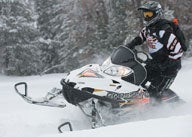
The "retro-Cat" with easily controlled power!
Arctic Cat took a beating when it discarded its popular Firecat chassis in favor of its ride-forward F-series design. When Cat fans like something, they don’t move forward easily. In some ways we don’t blame those Firecat F-7 riders for holding back. The first year or two of the all-new twin-spar chassis were a little shaky until Arctic Cat engineers turned the F-series from simply a good trail sled into a very ferocious trail gripper.
Engine Type:Horizontal In-line
Cylinders:2
Engine Stroke:2-Stroke
Valve Configuration:Reed Valve
Displacement:794 / 48.4
Starter:Electric
Turbocharged:No
View Full SpecEven so, not all Arctic Cat owners would admit the F-series was actually better than the old Firecat. To help these loyal Arctic Cat owners evolve, Arctic Cat engineers spent some time and effort updating its Firecat-based Crossfire stretch chassis to give these super Arctic Cat addicts something that was familiar, yet powered by the new generation of Arctic Cat engines.
Modern Versatility
We have to say that the 2010 Arctic Cat Crossfire models deliver modern performance in an aggressive, yet butt-back riding style. The newest Crossfires retain a Firecat heritage in seating, style, and outright performance. While the newest Crossfire bears throwback styling to the Firecat, it actually shares more with Arctic Cat’s lightweight mountain sleds than it does with the older trail sled.
We have to be brutally honest and state upfront that the Crossfire doesn’t do it for us at all. We have evolved to rider-forward seating and appreciate the exceptional cornering grip that Arctic Cat engineers designed into the latest F-series. We can appreciate the 2010 Crossfire, but it would not make our top 10 list of favorite sleds of the year!
What the Crossfire gives you is extreme versatility. We would not mess around with the 600cc Twin cylinder version at all. Go right for the 800 Twin.
Useable Power
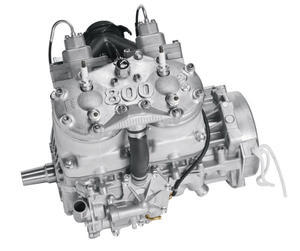 With a 4.3 pound lighter crankshaft the new 800cc twin revs very quickly.
With a 4.3 pound lighter crankshaft the new 800cc twin revs very quickly.
Let’s give Arctic Cat engine designers some major credit. They know how to build useable power that is both docile and ferocious. When this Minnesota-based powersports company introduced its 1000cc Thundercat ATV engine, it seemed very scary. Based on the specification sheet, you had to be a bit nervous about pushing in the throttle flipper. That motor develops oodles and oodles of brash, brutish torque. It has power than can get the front wheels off the ground without trying. Still, we found that Arctic Cat’s one-liter ATV engine responds responsibly to the throttle and can putt-putt around just as readily as it can tear up turf.
We point this out as a way of explaining our feelings toward the latest Arctic Cat 800cc Twin; the 160-horsepower one used in the top line Crossfire 800. Like the ATV motor, the new 800cc snowmobile engine is built to deliver serious power. Independent dyno-testing revealed a motor that amps out at 161-plus ponies with more than 106 ft-lbs of torque! That is some serious attitude.
Fortunately this latest collaboration between Arctic Cat and its engine partner, Suzuki, called for a motor that responds as demurely as a 120-hp category Twin, while being capable of ramping up very quickly for power running through off-trail powder.
Consider this sled as one of the very best for serious boondocking. Its batteryless electronic fuel injection, which Arctic successfully developed, allows the engine to modulate easily for trail cruising. Or, more importantly when you are venturing off trail and want to ease in or out of a tricky section of powder. Sleds with spiky throttle response could easily put too much power to the track, get it to spin and leave you needing to grab a handful of power and reacting very quickly to keep from getting bogged down trying to break a trail over a stump or around a wind blown tree line.
When we test rode a variety of 800cc powered Arctic Cats last winter, we had a very powerful and very positive impression of this new 800cc Twin. The throttle pull seemed light like a 600cc Twin. You knew the big Twin had excellent power, but it was all manageable and seemed spread across the power band. The more you engaged the throttle flipper, the more power you got — not in a disconcerting burst, but in a nicely manageable way. This might be what made the Crossfire 800 feel as light and nimble as the 600cc-powered version, which offers 30 horsepower and about 20 lbs-ft of torque less.
Lighter Weight
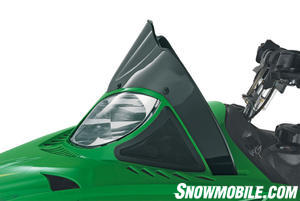 New permeable vent coverings keep snow dust out when running through powder.
New permeable vent coverings keep snow dust out when running through powder.
Crossfire loyalists like this “retro” sled for its power and its off-trail capability. In the past two seasons, the Crossfire series dropped more than 40-pounds in weight. The previous season Arctic Cat boasted that its engineers shed 35 pounds from the 2009 Crossfire. For 2010 those engineers shed more weight — 4.3 pounds were lost with a lighter crankshaft that allows the engine to rev up very quickly.
Lighter weight and more power blend nicely with the aggressive profile of a Cobra track that measures 141-inches in circumference with a 15-inch width. The base track profile measures 1.25-inches, but opting for the Sno Pro version gives you a taller 1.5-inch lug.
Fitted to this butt-back seating design you’ll find Arctic Cat’s older AWS VI front end. Of course, since off-trail versatility demands slick movement through powder, the Crossfire models share the adjustable ski stance seen on the deep powder M-series. You can set the Crossfire for trail cornering power at 44-inches of center-to-center ski stance or narrow the stance to 42-inches. The narrower stance gives you more flexibility in side-to-side “flickability” for riding in deeper, ungroomed snows.
The base Crossfire models come with Fox Zero Pro gas shocks. The Sno Pro model adds lighter Fox Float shocks.
M-Series Features
Again drawing from the M-series, the Crossfire Sno Pro features a version of the Float rear suspension, including a springless Fox Float air shock. The base Crossfire version works well enough with its Fox Zero Pro shocks and torsion spring tuning. Expect up to 17-inches of travel at the rear with 9.2-inches at the skis.
You’ll find the Crossfire models traverse terrain as though they are downsized M-series models, which in many ways they are. They provide a superior on-trail experience than an M-series though. The addition of the telescoping handlebar with its one-hand operation and 12 settings comes directly from the M-series. Raise the bar for breaking power or leave it down for trail cruising. There’s also a handy strap to help you heel the sled over if necessary.
Overall, the Crossfire not only satisfies the Firecat hangers-on in style and performance, but also exceeds the expectations of those loyal Cat riders when venturing off trail. While it may be a bit “retro,” the 2010 Arctic Cat Crossfire is modern as any other Arctic Cat for this season. The two-stroke engine offers the ease of pushbutton electronic reverse. The Crossfire adds a comfy saddle with a modicum of storage and ample ride protection from a very functional windshield.
If you like to break your own trail, you must consider Arctic Cat’s Crossfire. We’d say go for it and get the powerful 800cc Twin. We can’t imagine you’d be disappointed.
| 2010 Arctic Cat Crossfire 8 Specs | |
| Engine | Arctic/Suzuki 794cc, two-stroke, liquid-cooled, twin; 46mm throttle body, batteryless electronic fuel injection |
| Horsepower | 160-plus |
| Drive | Arctic RPM sensing drive with Arctic roller cam ACT driven |
| Front Suspension | Arctic AWS VI A-arm suspension; Fox Zero Pro shocks; 9.2-inches of travel; (Sno Pro version: Fox Float Air Shocks) |
| Rear Suspension | Arctic Fastrack long travel parallel rail slide with Fox Zero Pro shocks; up to 17.0-inches of travel; (Sno Pro version: Fox Float Air Shocks) |
| Length | 123.0 in |
| Width | 48.0 in |
| Ski Stance | Adjustable: 42 – 44 in. |
| Track | 15 x 141 x 1.25 (Sno Pro: 15x141x1.5) Cobra |
| Weight | N/A |
| Fuel Capacity | 12.2 US Gal |
| MSRP | US$10,499 |
Related Reading
2010 Arctic Cat M8 Review
2010 Arctic Cat F8 LXR Review
2010 Arctic Cat F8 Sno Pro Review
2009 Arctic Cat Crossfire R 8 Review
2009 Arctic Cat Crossfire 5 Review
All Things Arctic Cat on Snowmobile.com



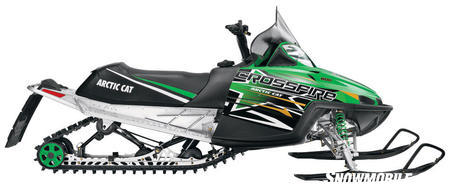
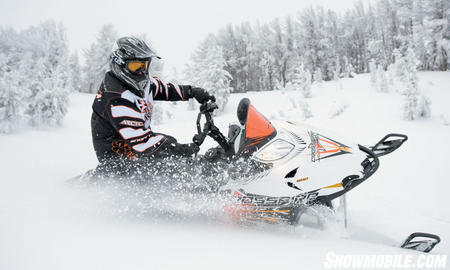
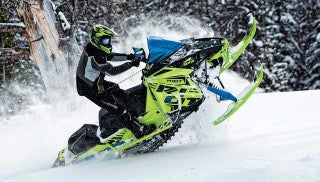
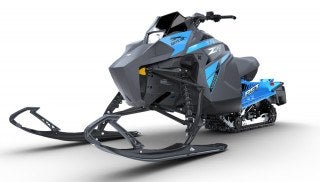



 Your Privacy Choices
Your Privacy Choices